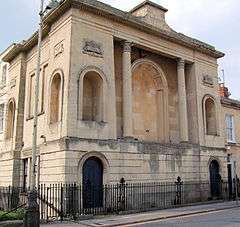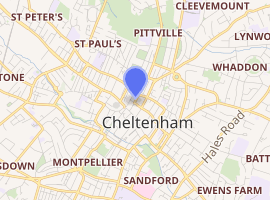Cheltenham Masonic Hall
The Cheltenham Masonic Hall is believed to be the second oldest purpose-built Masonic Lodge in England.[1] Grand Lodge in London did not build a purpose built lodge room until 1877. It is one of the few Temples in the country which has continuously been used as a Lodge room for considerably over 100 years.
| Cheltenham Masonic Hall | |
|---|---|
 | |

| |
| General information | |
| Town or city | Cheltenham, Gloucestershire |
| Country | England |
| Coordinates | 51°54′07″N 02°04′24″W |
| Design and construction | |
| Architect | G. Underwood |
It is also the oldest public building, other than ecclesiastical, in Cheltenham still used for the purpose for which it was designed.
The building
A grade II* listed building,[1] the history of the Cheltenham Masonic Temple began on 5 August 1818, when Brother Baynes proposed "that the propriety of erecting a new Lodge Room should be discussed at the next Lodge." A month later, at a meeting of the Foundation Lodge held at Sheldon's Hotel (now the site of the Labour Exchange) in York Passage, the Lodge agreed to start making plans for the new building.
The external appearance of the stone building has a few Masonic ornaments carved in the solid stone and two pillars on the main front.[1] The detail of the capitals is unusual; apparently it was meant for net work, lily work and pomegranates. At the four corners of the building are heavy tower-like projections which appear to contain chambers, possibly secret chambers such as were recommended by early writers on Masonic Temples. The building was designed to stand independently on the site of the garden, but houses have been built up against it on two sides.
The Foundation Lodge, Royal Union Lodge, the Foundation Chapter of Unanimity, Keystone Lodge of Mark Masons, Coteswold Preceptory, the Perseverance Lodge and The Mercurius Lodge have all used this building.
Within a year of the arrival of the Foundation Lodge in Cheltenham, plans were made to build the Masonic Hall, and a newly initiated brother, G. Underwood, was asked to prepare the plans and estimates.[2][3] Underwood had already made for himself a name as an architect and was at about that time engaged on the new church, Holy Trinity, in the same street. He was also the Surveyor employed by the Post Office for the first map of Cheltenham.
In May 1820, the plans were sent to H.R.H. the Duke of Sussex, The Grand Master.
The walls of the Refectory or Banquet Hall were elaborately painted with images of the canopied stalls of the Knights Templar, while at the window end of the same there are canopied recesses with recumbent effigies of Knights.[1] The carving on the mantlepiece bear emblems of the degrees of Malta and the Rose Croix is an especially interesting representation of the Bridge over the River and the Cross with a serpent on the shield; and even the cast iron grate having the Maltese Cross.
Over one door is the Paschal Lamb, the badge of the Knights Templar. Over another is a Bible on a cushion, whilst over the door to the passage is the armour and helmet of a Knight Templar and a motto, "Quis Domine Habitabat."
The ceiling was painted to resemble the lines of a tent, representing the canopy of an encampment. It was removed by Brother C. Rainger after it became defective and dirty. This brother was also responsible for the work of uncovering the paintings on the walls, which were papered over for some twenty years or more.
Site
The site of the Masonic Hall must have been an important one in 1818, the price given for it was considerable. Originally the building stood independently in the large garden, but the area has been built up. The existing garden is now surrounded by a box tree hedge and an old acacia tree.
The Lodge Furniture
The building has many old and valuable pieces of furniture contained in the Lodge. The Worshipful Masters, Senior and Junior Wardens chairs in the regular use of all the Lodges are the property of the Royal Union. They are of similar, though not identical design and are fine examples of Georgian craftsmanship apart from their Masonic interest.
The Worshipful Master's chair has two Corinthian columns and is decorated with four plumb rules on the several faces of the legs, but it is also decorated with the square and compasses and on the back the open book of the sacred word, square and compasses and the level and plumb rule. Surmounting the columns were two globes, now gone, and at the back is the mark of a support for a lantern which is now removed. On the top of the ornament over the back is a Royal Crown which has been added on at a later date. This crown implies that the chair was in use for the Royal Arch Degree, or it may refer to the Lodge being a "Royal" Lodge.
The Senior Warden's Chair has some delicate little emblems introduced in the carving – the Fellow Craft tools and the Senior Warden level, in a supporting ribbon.
The Junior Warden's Chair has been broken and a new top of a different style added on, containing a group of tools. The two columns supporting the back are unfluted and were Ionic columns, but the capitals are broken, whilst the upper parts have gone. The ornaments on the legs are of the plumb rule as in the W.M.'s chair.
There is also a set of five chairs of simple mahogany with badges for W.M., S.W., J.W. and two P.M.'s. The two beautiful little Chippendale pattern chairs generally used by the Deacons, are more recent gifts, were not made for Masonic Lodges, but were gifts of Brother John Waghorne.
The organ was given to the Lodge around 1833, and the Lodge roof was raised to accommodate it. It is played for masonic ceremonies on average 4 times per week and is still considered a good instrument.
References
- Historic England. "Masonic Hall (1387563)". National Heritage List for England. Retrieved 26 October 2019.
- "Cheltenham Heritage Open Days - Open Building - Masonic Hall". Visit Cheletenham. Retrieved 26 October 2019.
- "Cheltenham Masonic Hall". Provincial Grand Lodge of Gloucestershire. Retrieved 26 October 2019.
- Foundation Lodge 1753 to 1965 privately printed history by W Bro Paul Dyke.
- Records of Foundation Lodge, Gloucestershire Public Record Office,